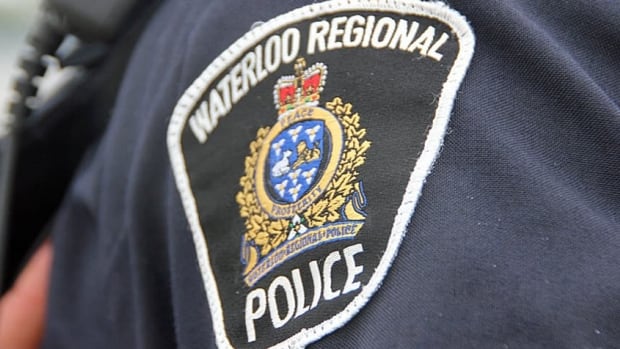

So far this month, there have been at least six police-reported, hate-motivated graffiti incidents in Ontario’s Waterloo region.
From writing found inside a bus shelter in Kitchener and a Waterloo ION LRT station, to symbols on a building in Cambridge and the front door of a business in Waterloo — these incidents are a priority for police to address.
“These things are always cause for concern for me,” said Waterloo Regional Police Staff Sgt. Eric Boynton, who is in charge of the equity diversity and inclusion unit.
“We’ll be looking to see if it’s a trend or if it’s an anomaly,” he added, noting that each month, police usually receive five to 10 reports of hate-related occurrences such as a dispute or graffiti.
As police continue to investigate and eventually prosecute these crimes, they’ll be leaning on a process that’s been enhanced over the last five years to emphasize restorative responses — an approach some members of impacted communities have longed for.
“Historically, we would address these things strictly from a crime basis … But what we realized is that we can’t arrest our way out of racism or hate-related crime,” said Boynton.
Engaging with victims is meaningful and shows our support, but also engaging differently with offenders when we can to make sure those things aren’t being done in the future and hopefully create a restorative outcome from harm.– Staff Sgt. Eric Boynton, Waterloo Regional Police Service
According to the federal government, restorative practices give “opportunities for victims, offenders and communities affected by a crime to communicate (directly or indirectly) about the causes, circumstances, and impact of that crime, and to address their related needs.”
Restorative justice — which is used across Canada, and supported by legislation and government programs and policies — “encourages meaningful engagement and accountability and provides an opportunity for healing, reparation and reintegration,” the federal website says.
This week, the City of Waterloo issued a statement condemning the recent graffiti incidents.
“There’s no place for hate, racism or any other harmful ‘ism’ that is meant or does cause fear or harm to diverse folks, folks in the 2sLGBTQ+ community, Indigenous community or any other person in our community,” Boynton said.
He said police are looking at the incidents through an equity, diversity and inclusion lens by providing support to victims and tapping into community organizations during the prosecution process for offenders, when possible.
“Engaging with victims is meaningful and shows our support, but also engaging differently with offenders when we can to make sure those things aren’t being done in the future and hopefully create a restorative outcome from harm.”
An individual who is convicted in a hate-motivated graffiti incident usually faces criminal charges such as mischief, since “graffiti” itself isn’t a crime under the Criminal Code.
“There is a section in the Criminal Code that allows for an increased sentence if that crime is shown to be motivated by hate,” said Boynton.
Continuing to investigate after hate-motivated graffiti was located in the area of King Street North and Dupont Street in Waterloo.<br><br>Call police or <a href=”https://twitter.com/WaterlooCrime?ref_src=twsrc%5Etfw”>@Waterloocrime</a> with information. Anonymous tips can also be submitted at <a href=”https://t.co/NvtqFvWWVb”>https://t.co/NvtqFvWWVb</a>.<br><br>Details: <a href=”https://t.co/DtIFCxxwIW”>https://t.co/DtIFCxxwIW</a>. <a href=”https://t.co/nwKCqjtfOx”>pic.twitter.com/nwKCqjtfOx</a>
—@WRPSToday
Boynton said that in recent years, other avenues have been offered in select cases to ensure an offender recognizes the harm caused and curtails that behaviour: for example, attending community dialogue circles, volunteering with impacted community members or taking educational programs, all led by grassroots organizations such as Community Justice Initiatives (CJI).
Sarah Shafiq is director of research, advocacy and youth programs with the Coalition of Muslim Women of KW, one of the organizations that works with CJI.
Shafiq said communities have been advocating for restorative responses to hate crime, and is glad it’s now formally integrated in the policing process.
“This is absolutely needed,” she said. “The restorative response tends to mend those relationships and re-educate or to remove the misinformation, and to provide [offenders] a chance to dialogue, a chance to actually connect and meet with ‘the other’ that they hate.
“We know that throwing somebody in jail, penalizing them like that, will not solve maybe the hate that they have, the ignorance that they have, the mis-education,” she said, adding this approach can help prevent crimes.
Shafiq said the coalition hasn’t recently heard of hate-motivated graffiti incidents targeting the Muslim community. However, it did receive a report of an incident targeting another group, through its online reporting tool for people who witness or experience incidents of hate or discrimination. Nonetheless, these incidents have wider impacts.
“Maybe it’s targeted at the particular individual, but then the whole community is witnessing that … there is an element of secondary trauma as this is something that the community witnesses — there is a feeling of lack of safety in where they’re living.”
More reporting encouraged
Boynton said the disproportionate number of graffiti cases this month could point to several outcomes, such as more people reporting to police — an increasing trend.
“Are we seeing an increase in these types of things or are we seeing an increase in trust which is leading to an increase in reporting? That’s what we’ve seen in part over the last few years.”
However, he said, police numbers aren’t matching those of community groups, meaning not enough people are reporting incidents.
“My hope is that number increases in the sense we see more reporting of these types of things,” he said.
“I know there are a lot of folks who do have trepidation about engaging with police, but … we really want to know about these things so the very least we can support victims … and if we able to determine who did what, there are so many avenues of addressing that, beyond the address and charge piece.”












